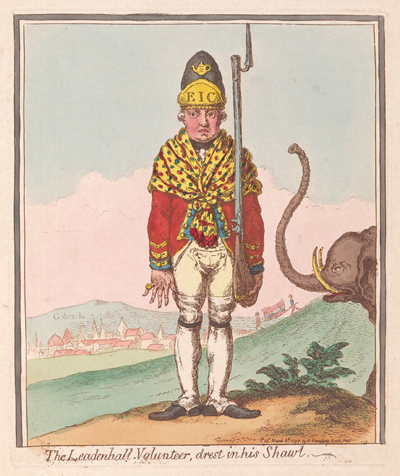The Leadenhall Volunteer, Drest in his Shawl
This has every indication of being a portrait caricature of someone from the East India Company, but, alas, I can't as yet offer an identification.

© Beinecke Rare Book and Manuscript Library, Yale University
Like most portrait caricatures, the print presents a single figure; and both the article in the title (The Leadenhall Volunteer not A Leadenhall Volunteer) and the individualized features of the face suggest that this is a specific person, not a generic volunteer. And again, like most portrait caricatures as far back as the Darly macaroni prints, the title and details of the print are intended to provide clues to the subject's identity. A number of details point to India and the East India Company: the presence of the elephant next to the volunteer, the palanquin descending the hill in the background, the "EIC" and teapot on the volunteer's cap, and, of course, the title of the print itself—Leadenhall Street being the London address of the East India Company.
But the Indian references are even more specific: the city of Golconda in southern India near Hyderabad is sketched and identified in the background. The shawl and the ring worn by the volunteer are also likely to have been intended as clues. Golconda was famous for its chintz (intricately painted cotton cloth) as well as its diamond mines.
In early 1797, the threat of an invasion by France seemed more real than ever. A French landing at Bantry Bay in Ireland with as many as 44 ships and 20,000 troops in late December had been averted almost entirely by the chance intervention of a violent winter storm. So there was a renewed interest in the creation of volunteer forces to augment the local militias, especially in coastal areas. Most of these volunteer forces were associated with very specific locales. For instance, in Rowlandson's Loyal Volunteers of London & Environs published by Ackermann the following year in 1798, There are companies associated with Richmond, Covent Garden, Temple Bar & St Paul's, Newington-Surry, St. James's, Westminster, and many others areas. But the East India Company had its own volunteer force created (according to Cecil Sebag-Montefiore) in 1796. By 1797, it had increased to three regiments.
Gillray would certainly have known all this and seen the opportunity that prints about volunteers would offer. A few days earlier he had produced a satiric print featuring volunteers from St. George's. But the volunteer, in this print, whoever he is, seems to be located in southern India, near Golconda presumably protecting British East India Company assets there. If anyone can establish his identity, I would love to hear about it.
Sources and Reading
- Commentary from the British Museum on The Leadenhall Volunteer, Drest in his Shawl.
- "British Volunteer Corps," Wikipedia
- "Militia (Great Britain)," Wikipedia
- Cecil Sebag-Montefiore, A History of the Volunteer Forces from the Earliest Times to the Year 1860, 1908
- Thomas Wright and Joseph Grego, The Works of James Gillray, the Caricaturist; With the History of His Life and Times p. 221.
Comments & Corrections
NOTE: Comments and/or corrections are always appreciated. To make that easier, I have included a form below that you can use. I promise never to share any of the info provided without your express permission.